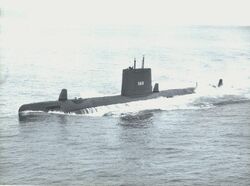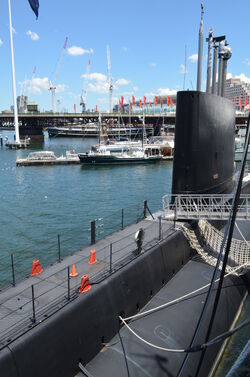
USS Harder with the three distinctive shark-fin PUFFS domes.
What is 'pasive sonar'?[]

Fin and central section of HMAS Onslow. The three orange covers on the casing are protective sheathes over the submarine's Micropuffs sonar.
Sonar was (originally an acronym for: SOund Navigation And Ranging), wich is a technique that uses sound propagation (usually underwater, as in submarine navigation) to navigate, communicate with or detect objects on or under the surface of the water, such as other vessels. Two types of technology share the name "sonar": passive sonar is essentially listening for the sound made by vessels; active sonar is emitting pulses of sounds and listening for echoes. Sonar may be used as a means of acoustic location and of measurement of the echo characteristics of "targets" in the water. Acoustic location in air was used before the introduction of radar. Sonar may also be used in air for robot navigation, and SODAR (an upward looking in-air sonar) is used for atmospheric investigations. The term sonar is also used for the equipment used to generate and receive the sound. The acoustic frequencies used in sonar systems vary from very low (infrasonic) to extremely high (ultrasonic). The study of underwater sound is known as underwater acoustics or hydroacoustics.
Passive sonar listens without transmitting. It is often employed in military settings, although it is also used in science applications, e.g., detecting fish for presence/absence studies in various aquatic environments - see also passive acoustics and passive radar. In the very broadest usage, this term can encompass virtually any analytical technique involving remotely generated sound, though it is usually restricted to techniques applied in an aquatic environment.
The plan[]
Passive Underwater Fire Control Feasibility System (or Study) (PUFFS) was a passive sonar system for submarines. It was to be used om United States Navy conventional submarines converted to GUPPY III or otherwise modernised in the 1960s.
The system[]
The planned subs[]
The system was designated AN/BQG-4 and was primarily equipped on United States Navy conventional submarines converted to GUPPY III or otherwise modernized in the 1960s. It was also equipped on the nuclear-powered USS Tullibee (SSN-597). A version known as "Micropuffs" was fitted on Oberon-class submarines for the Royal Australian Navy, and as Type 2041 on Upholder/Victoria-class submarines for the British Royal Navy. This class still serves in the Royal Canadian Navy, where Micropuffs is known as BQG-501.
The system was notable for three tall, fin-like domes topside, except on Micropuffs installations. The system was retained on several submarines transferred to foreign navies. It was associated with long-range passive detection of targets for the Mark 45 nuclear torpedo and other torpedoes as well.
The retrofitted subs[]
Most submarines backfitted with it were also lengthened 12-16 feet to accommodate additional electronics and plotting rooms. It was also planned for Thresher and Sturgeon-class nuclear submarines, but was not fitted on them except Micropuffs experimentally on Barb and Haddock. With the exception of the four Canadian Upholder/Victoria class submarines, all PUFFS-equipped submarines have been disposed of or preserved as museum ships.
Also see[]
- Radar
- Sonar
- Radome
- Submarines
- Mark 45 nuclear torpedo
- Greater Underwater Propulsion Power Program (GUPPY)
Outside links[]
- https://en.wikipedia.org/wiki/Passive_Underwater_Fire_Control_Feasibility_System
- http://www.acronymfinder.com/PUFFS.html
- http://www.digplanet.com/wiki/Passive_Underwater_Fire_Control_Feasibility_System
- http://acronyms.thefreedictionary.com/Passive+Underwater+Fire+Control+Feasibility+System
- https://images.search.yahoo.com/search/images;_ylt=A0LEV0fqQzhYpYsArBpXNyoA;_ylu=X3oDMTEyNGJsOGU5BGNvbG8DYmYxBHBvcwMxBHZ0aWQDQjMxMTNfMQRzZWMDc2M-?p=Passive+Sonar&fr=dss_yset_chr
- http://oceanservice.noaa.gov/facts/sonar.html
- http://www.tutapoint.com/knowledge-center/view/passive-vs-active-sonar/
- https://www.wikiwand.com/en/Sonar#/Passive_sonar
- http://encyclopedia2.thefreedictionary.com/Passive+sonar